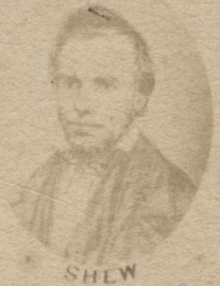Joel Shew | |
|---|---|
 | |
| Born | November 13, 1816 |
| Died | October 6, 1855 |
| Occupation(s) | Hydrotherapist, writer |
Joel Shew (November 13, 1816 - October 6, 1855)[1] was an American physician, hydrotherapist and natural hygiene advocate.
Biography
[edit]Shew was born in Providence, Saratoga County. He worked in a daguerreotype shop in Philadelphia and obtained his medical degree in 1843.[2] Shew took interest in hydrotherapy and visited Gräfenberg to study Vincenz Priessnitz's techniques.[3][4] His wife, Marie Louise Shew was also a hydrotherapist. They were friends of Mary Gove Nichols who had temporarily lodged at their house. The Shews operated a hydrotherapy "water-cure" house and opened it to patients.[2]
In 1844, Shew established the first water-cure institution in New York City.[3] In May 1845, he opened the New Lebanon Springs Water-Cure Establishment, which cost about US$3,000.[5] He was the co-owner and advising physician. David Campbell was its manager for ten years.[5] Shew was influenced by the dieting ideas of Sylvester Graham and promoted natural hygiene practices such as bathing, exercise and massage as well as the elimination of alcohol and tobacco.[3] Historian Stephen Nissenbaum has noted "it is clear that Shew was a Grahamite before he discovered the water-cure".[6] Shew and his wife were vegetarian.[7]
In 1850, Shew wrote notes and additions for the American edition of William Lambe's Water and Vegetable Diet.[8] He died at Oyster Bay, Long Island.[1] An autopsy revealed an enlarged liver and internal lesions. This may have been caused by the chemicals he was exposed to during his earlier career as a photographer.[9]
The Water-Cure Journal
[edit]In 1845, Shew launched The Water-Cure Journal. After 1850, it had a subscription list of 50,000.[3] Russell Trall edited the journal from 1849 and it was later renamed, The Herald of Health.[10][11][12]
Selected publications
[edit]- Facts in Hydropathy or Water Cure (1844)
- Water-Cure for Ladies (Marie Louise Shew, revised by Joel Shew, 1844)
- Hydropathy, Or, The Water-Cure (1845)
- The Water-Cure Manual (1847)
- Tobacco: Its History, Nature, and Effects on the Body and Mind (1849)
- Water and Vegetable Diet (William Lambe, notes and additions by Joel Shew, 1850)
- Consumption: Its Prevention and Cure by the Water Treatment (1851)
- The Hydropathic Family Physician (1854)
References
[edit]- ^ a b Kelly, Howard A; Burrage, Walter L. (1920). American Medical Biographies. Baltimore: The Norman, Remington company. p. 1045
- ^ a b Silver-Isenstadt, Jean L. (2002). Shameless: The Visionary Life of Mary Gove Nichols. Johns Hopkins University Press. p. 76. ISBN 0-8018-6848-3
- ^ a b c d Engs, Ruth Clifford. (2000). Clean Living Movements: American Cycles of Health Reform. Greenwood Publishing Group. p. 96. ISBN 0-275-97541-X
- ^ Schwarz, Richard W. (2006). John Harvey Kellogg, M.D.: Pioneering Health Reformer. Review and Herald Publishing Association. pp. 25-26. ISBN 0-8280-1039-8, 0-8280-1939-8
- ^ a b Marchese, Allison Guertin. (2014). Hidden History of Columbia County, New York. The History Press. p. 94. ISBN 978-1626193956
- ^ Nissenbaum, Stephen. (1980). Sex, Diet, and Debility in Jacksonian America: Sylvester Graham and Health Reform. Greenwood Press. p. 156. ISBN 978-0313214158
- ^ Shprintzen, Adam D. (2013). The Vegetarian Crusade: The Rise of an American Reform Movement, 1817-1921. University of North Carolina Press. p. 55. ISBN 978-1-4696-0891-4
- ^ Hoolihan, Christopher. (2001). An Annotated Catalogue of the Edward C. Atwater Collection of American Popular Medicine and Health Reform, Volume 1. University of Rochester Press. p. 603. ISBN 1-58046-098-4
- ^ Wrobel, Arthur. (1987). Pseudo-Science and Society in 19th-Century America. p. 81. University Press of Kentucky. ISBN 978-0-8131-5544-9
- ^ Whorton, James C. (2002). Nature Cures: The History of Alternative Medicine in America. Oxford University Press. pp. 90-91. ISBN 0-19-514071-0
- ^ Hoolihan, Christopher. (2008). An Annotated Catalogue of the Edward C. Atwater Collection of American Popular Medicine and Health Reform, Volume 3. University of Rochester Press. p. 344. ISBN 978-1-58046-284-6
- ^ Smith, Andrew F. (2009). Eating History: Thirty Turning Points in the Making of American Cuisine. Columbia University Press. p. 34. ISBN 978-0-231-14092-8
Well, that’s interesting to know that Psilotum nudum are known as whisk ferns. Psilotum nudum is the commoner species of the two. While the P. flaccidum is a rare species and is found in the tropical islands. Both the species are usually epiphytic in habit and grow upon tree ferns. These species may also be terrestrial and grow in humus or in the crevices of the rocks.
View the detailed Guide of Psilotum nudum: Detailed Study Of Psilotum Nudum (Whisk Fern), Classification, Anatomy, Reproduction